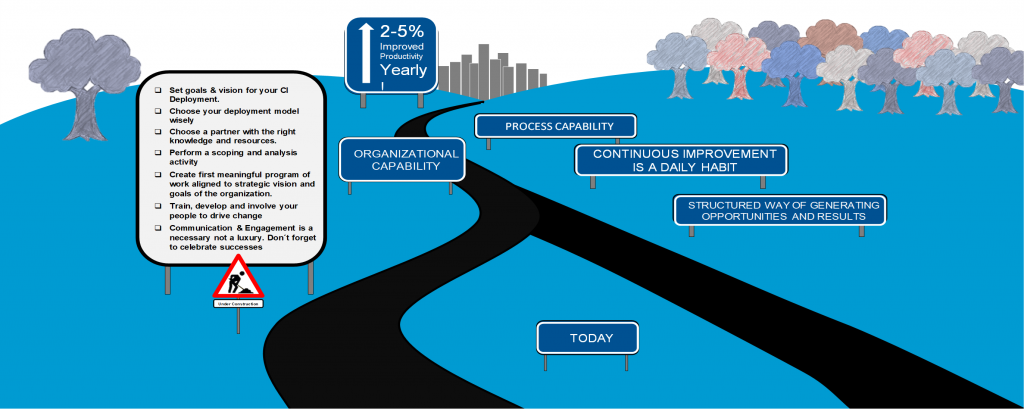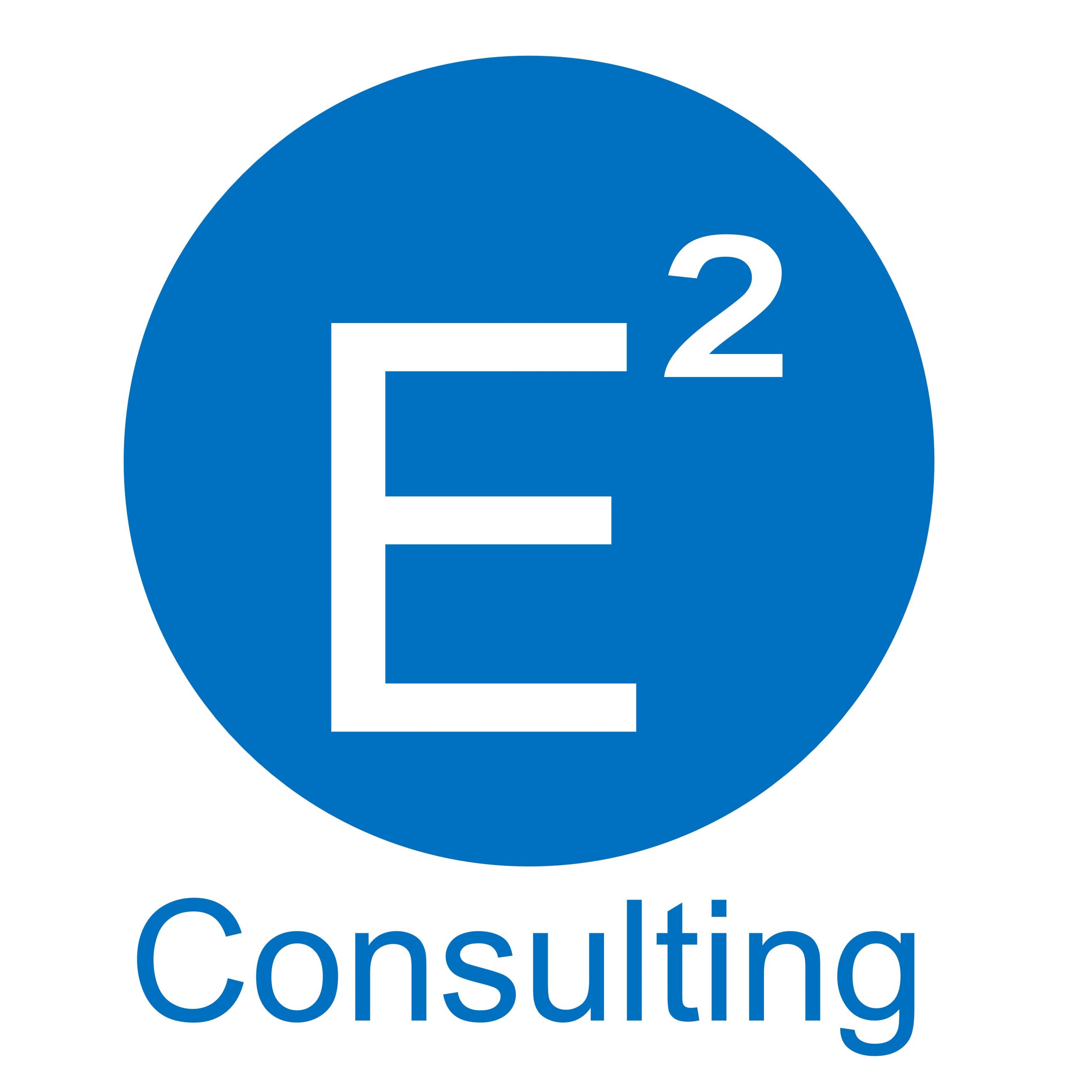Operational Excellence has been heralded as a capability that every successful organization needs to continually transform their performance and reinvent their results on a perpetual basis. Strange then, most organizations that embark on this journey simply FAIL. Most don’t publicly acknowledge this but still, it is true, in either the short or medium term their efforts are not sustainable.

What is an appropriate goal for an Operational Excellence Deployment?
2-5% organic productivity improvement year on year is the short answer. The long answer can be something like this:
- Our CI Deployment will build capability in our organization to deliver the right improvements for the business at the right time and on a continual basis. Our efforts will be aligned to our business’s strategic direction.
- Leadership and coaching will drive the right behaviors and grow our people, so we can utilize our organization’s full potential. Our leaders will be appropriately robust in their challenges to their organizations, their teams, and each other. We want our leaders to be positively dissatisfied with the status quo and actively seek stretching targets.
- We want our leaders to be well-versed in CI methodologies and actively promote and grow the capabilities, to this end we want their ranks to be filled with CI Leads and Experts.
- We want the critical mass of our organization to use the CI tools in their daily work as a standard.
- Our governance and prioritization process supports us to deliver on time and in full and use our resources optimally.
- We will use a structured analysis approach that leverages our growing comfort with data-based decision-making to build a robust pipeline of opportunities that support our strategic imperatives.
What are the different deployment models that can be considered?

Classic Deployment Model
Continuous improvement (CI) experts are hired from within the org, and training and coaching are provided by 3rd party initially before being brought in-house. Projects/improvement identified by good ideas and historical problem areas. Leaders are educated by external resources or as the education & capability of internal candidates allow. Involvement of wider organization limited to project areas for the first year typically. Capability development of the wider organization is very limited and usually doesn’t begin in a significant way until 2nd or 3rd year of deployment.
Benefits of the classic model
- Lowest cost start-up model. ROI 18-24 month
- Projects identified and launched quickly
- Outward appearance of rapid progress to shareholders/customers.
Risks of the classic model
- Projects are often badly chosen and are not real burning platforms or require other improvements to be done first (bad sequencing).
- New CI experts are slow to deliver initial improvements as they are learning a new craft/role which requires many new skills/capabilities to be developed.
- Limited involvement by the organization so culture changes towards structured improvement goes slow.
- Speed of deployment is too slow and the whole initiative can collapse
Hybrid Deployment Model
As Classic but detailed analysis performed by External Expertise (eventually internal capability will do this) to identify structure improvement activity and define good scopes.
Benefits of the hybrid model
- Good project scopes identified so false start projects are significantly reduced. ROI 12 – 18 month
- Initial progress is a little slower due to performing detailed analysis but results ultimately come faster than classic as projects are better formed and address real business issues and needs.
Risks of the hybrid model
- As Classic but resource is still often scattered across multiple parts of organization so creating real momentum is challenging.
Lighthouse Deployment Model
CI experts hired from within, trained and coached by 3rd party experts. Deployed with 3rd party change delivery experts working on closely connected projects as part of the same team, like “Hunting in packs”. As Hybrid but with internal CI resources working as part of a mixed external/internal analysis team. Organizational involvement significantly increases as is pace of change. Capability development of wider organization supported by Ext Experts but all capability development linked to connected project portfolio.
Benefits
- Fast delivery of projects and benefits, financial delivery much higher as less opportunity left on the table from each project. Costs much higher but ROI < 12 months and often quicker.
- Good project scopes identified so false start projects are significantly reduced. ROI 12 – 18 month
- Initial progress is a little slower due to performing detailed analysis but results ultimately come faster than classic as projects are better formed and address real business issues and needs.
- Capability development of wider organization grows quickly.
- CI as a way of working embeds and the risk of deployment failure significantly lower. CI expert and leader development much faster (coached every day)
Risks
- Sections of the organization will/may see very limited involvement initially.
- Sequencing, engagement, and communication are essential as the closely connected approach can leave pockets with apparently no improvement activity running.
The lighthouse model has most chance to be truly successful both on long and short term when we compare risks and benefits. Do you want to know more, connect with E2 consulting.
What more do we need to master for long term success after we have chosen the right deployment model?
We need to have strong executive sponsorship and senior management support for the deployment. Our employees also need to be heavily involved in the full change process, including effective change champion/s. The organization needs to understand the complexity of the projects/change, failure often comes from the assumption that it would be simple and easy. We need to be aware of that change is just not adding as an extra task. It’s an investment, nothing worthwhile comes for FREE. Change takes time and needs a proper plan.
Master to really link Vision, Strategy and Goals of business to the Improvement program and truthfully measuring your return on the investment.
No fear to STOP existing activities or projects, too much at the same time can kill the best of improvements. Don´t forget that communication is a necessity, not a luxury and be sure to plan for quick wins as well.
Finally a short summary on how to start your deployment
- Set goals & vision for your CI Deployment.
- Choose your deployment model wisely
- Choose a partner with the right knowledge and resources.
- Perform a scoping and analysis activity
- Create first meaningful program of work aligned to strategic vision and goals of the organization.
- Train, develop and involve your people to drive change

